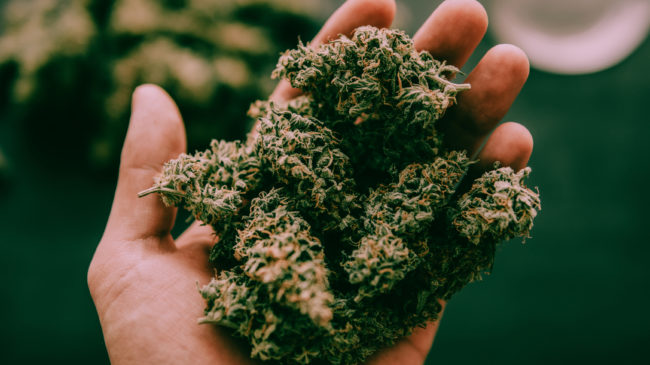South Dakota Amendment A: Marijuana Legalization Initiative
Summary
South Dakota’s Amendment A would amend the state constitution to legalize marijuana for adults 21 and older, allowing them to possess or distribute up to one ounce of marijuana. Individuals with access to a licensed retail store would be allowed to grow up to three marijuana plants in a private residence in a locked space (up to six plants per residence).
It would require the Department of Revenue to adopt rules and regulations including the issuance of licenses, health and safety requirements, and other areas, and assess a tax of 15 percent on sales. After covering costs associated with implementing legalization, the remaining revenue would be divided evenly between state public schools and the general fund. Local governments are permitted to ban any marijuana facilities within their limits but cannot prevent licensed deliveries of marijuana, and they may also only limit and regulate licensed marijuana establishments.
The amendment would require the South Dakota State Legislature to pass laws providing for a program for medical marijuana and the sale of hemp by April 1, 2022.
Fiscal Impact
The South Dakota Legislative Research Council estimates that Amendment A would decrease prison costs in the state and would lead to net revenues of almost $11 million in 2022 and over $29 million by 2024.
Proponents’ Arguments For
Proponents argue that marijuana prohibition has failed and now most South Dakotans oppose it. They say Amendment A would end thousands of pointless, harmful, and costly marijuana arrests each year, reducing the burden on police officers and letting them focus on serious crimes. It would help veterans and others suffering from debilitating medical conditions, raise the revenue needed for public schools and the state general fund while creating and boosting the economy.
Supporters say Amendment A is a constitutional amendment needed so the people’s will is carried out and can’t be changed at a whim of the legislature. It sets up a commonsense system to end the illegal black market for marijuana, move the workers in this industry into the legal economy, and regulate it for safety and tax it like other goods.
Opponents’ Arguments Against
Opponents argue that Amendment A will increase young people’s exposure to and use of marijuana and lead to an increase in fatal car accidents from impaired driving. While Amendment A allows businesses to refuse to hire people that fail a drug test now, some states have changed their laws to prohibit businesses from using a failed drug test as a reason to not hire an applicant. Business groups say the result will be decreased productivity, increased worker comp and unemployment comp claims, high turnover, and lawsuits. The state medical association says marijuana is a hazardous drug and public health concern. Law enforcement says legalization will complicate law enforcement efforts and lead to more use of marijuana.
States like Colorado have seen costs of treating addiction and social problems caused by legal marijuana outstrip new tax revenue from marijuana sales. Opponents believe that little new money will wind up going to South Dakota schools.
Discussion
South Dakota can become the first state to simultaneously approve cannabis decriminalization and licensing for both medical and adult-use this election. Both Amendment A and Measure 26 would legally authorize limited possession and use while establishing general legal guidelines for future policy implementation (including business licensing and regulation) over the coming year.
Amendment A comes down to what voters think about legalizing marijuana. Adult recreational use of marijuana is currently legal in 11 states, and more and more people seem to be persuaded it is a good idea. National polling from Pew Research Center shows 67 percent of American adults say marijuana should be legal (including 55 percent of Republicans and Republican leaners), and adults who oppose legalization has fallen from 52 percent in 2010 to 32 percent today. In South Dakota, almost 60 percent of voters support Amendment A.
A May 2020 YouGov poll of residents of nine states that have legalized marijuana asked if they think it is a success or failure. In five of the states, two-thirds or more of voters think it is a success, and only one state (Maine) less than a majority (47%) think it is a success. In every state, 20 percent or less think legalization is a failure.
It is worth examining the key arguments by both sides.
Estimates of state revenues can be complex and states should be conservative in estimating revenues until they have experience and data to rely upon. All states that have legalized have seen considerable state revenues. The states that most heavily regulate and tax the legal market, stunting the growth of the legal market, have seen the least reduction in the black market and generated considerably less state revenue than might have been realized in a more successful legalized market.
The same is certainly true for creating legal marijuana market jobs. Overall job growth in the industry is robust: a 2019 nationwide analysis found 211,000 jobs in the legal cannabis industry, and that workforce increased 21 percent in 2017, another 44 percent in 2018, and anticipated at least another 20 percent growth in jobs in 2019.
Opponents of legalizing marijuana argue that it will impose societal costs like more victims of drugged driving accidents and rising use by juveniles. These matters bear more examination, but keep in mind that they are all true of black-market marijuana, are almost all true of alcohol, and none of these were reasons why marijuana was made illegal in the first place.
Overall, research on states that have legalized medical marijuana or decriminalized marijuana possession and use has found no increase in juvenile use. And a 2019 study in the Journal of the American Medical Association found that legalizing recreational marijuana use for adults was followed by an average 8 percent decrease in juvenile use in Oregon and Colorado. Nationwide, juvenile use of marijuana has been falling since 2011, the year prior to legalization in the first states to do so—Colorado and Washington.
Studies on the effect of marijuana legalization on traffic accidents are inconclusive, as it is hard to isolate the effects due to mixed use of alcohol and THC, difficult to measure THC impairment, and difficult to separate confounding effects like marijuana use reducing drunk driving.
Employers have not been dramatically affected by marijuana legalization, and drug-free workplace policies have remained commonplace in legalized states.
Even while marijuana is predominantly bought and sold in the black market, without either private and competitive incentives for quality control and safety or any regulations with the same goal, current data show that marijuana has fewer health risks than either alcohol or tobacco. Legalizing marijuana and ending black markets would likely improve its safety.
One clear lesson from states that have legalized recreational marijuana is that the rules must evolve and adapt to fit the particulars of the state market and related laws. Amendment A leaves to the legislature and Department of Revenue to develop detailed rules and regulations building on the rules and proscriptions included in the amendment.
Voters’ Guide to Other Marijuana Legalization and Drug Policy 2020 Ballot Initiatives
Voters’ Guides to 2020 Ballot Initiatives on Other Policy Topics



